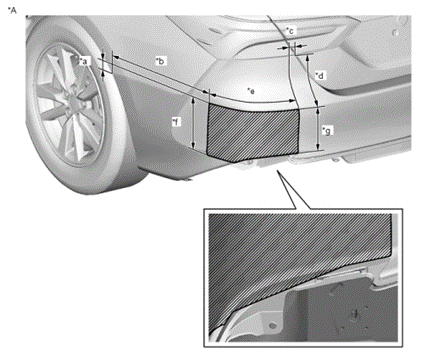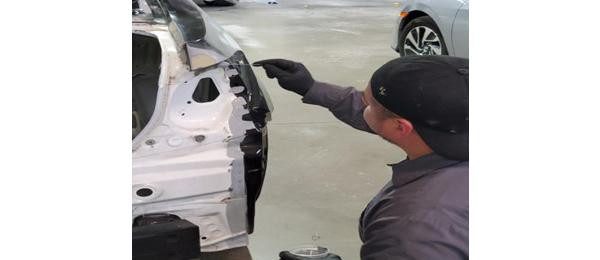The 2021 Toyota Camry pictured above has dents in the left front fender and left rear bumper corner, circled in black. Note the repair time needed on the fender and rear bumper.
Now list each repair step needed before the vehicle goes to paint. To get you started, here are the first few line items: R&I or lower the front bumper, R&I front left headlamp (possible aim), remove paint from dent in left front fender, and list each item necessary on damaged front fender. Do the same with the rear bumper.
Five questions: Does your shop follow OEM repair procedures? Does your shop have access to OEM repair data? Does your shop print out repair data on every car it repairs? Have you or your estimator opened www.oem1stop.com? Have you or your estimator opened The Guide to Complete Repair Planning at www.scrs.com?
A couple of months ago, I was conducting training at a Honda Certified collision shop on the KECO Glue Pull Repair System. The first item on my procedure list was to look up the OEM data for the vehicle. The owner of the shop was in the class and he said it was not necessary on the Honda Accord they were repairing.
I asked the owner if, before the shop had the KECO system, the tech would grind off the paint to expose the bare metal and pull out the dent with a Dent Fix MAXI, followed by plastic filler. The owner said yes. So asked him the above five questions. The owner answered "yes" to the first two, but "no" to the last three.
Honda states on www.oem1stop.com that "You must apply 2K epoxy to all bare metal surfaces prior to applying any seam sealer, body filler or other refinishing products."
The owner was taken aback. I asked how the KECO system was working and if I needed to come back for additional training. The owner said everything was going well and the shop was using Car-Prep 2K Epoxy Primer on all bare metal -- more on this later.
Have you noticed how many ads for accident attorneys are on TV today? They all brag about the million-dollar settlements or billions of dollars they "won" for their clients. It is only a matter of time before some attorneys will go after collision shops for not following OEM procedures in the repair process.
Think of this with above mentioned shop. The vehicle owner gets an attorney because they are not happy with the repairs. The shop gets a call that the attorney is going to file a lawsuit, unless the shop pays some outrageous amount to make it go away. The shop decides it is cheaper to pay than going to court. This scenario is hypothetical, but it will become reality.
Let's looks at Toyota's repair processes.
Toyota's Collision Repair Information Bulletin (CRIB) #186, dated September 2013, titled "Corrosion Prevention for Collision Repair," states the following: "Electro-Deposition Primer (E-Coat) on production vehicles and service parts offers a degree of corrosion protection. Whenever possible, E-Coat should be left intact. When E-Coat is damaged or removed, it should be replicated with two-component (2K) DTM (not the one in a spray can) or Epoxy Primer. Etch Primer cannot exhibit the corrosion prevention characteristics of DTM or Epoxy Primer and E-Coat over the long-term and therefore is not recommended as a substitute for E-Coat, DTM or Epoxy Primer."
Next, I want to review Toyota's year- and vehicle-specific repair data for the blind spot monitors on the back of the quarter panel near the corner. The document shows an area approximately 15 inches by 8 inches where no repairs are allowed, and states slight damage can be filled by a primer surfacer or paint.

Be honest, would you have printed out the repair data for the damage on the 2021 Toyota Camry at the top of the article? Over the past month, I asked shop owners, estimators and managers if they would have, and to a person, they said no. Some knew about the repair to the repair bumper and one owner, who had just returned from an OEM certification program, knew about the epoxy primer.
Let's turn our attention to the various types of corrosion protection primers used in the manufacturing and collision repair processes in order to understand the OE repair data and justify its use on an estimate.
Most car bodies manufactured today come with an electrophoretic coating (e-coat) layer underneath the primer that provides excellent corrosion protection.
In the automotive e-coat process (electrodeposition), the car body is negatively charged and the paint solids -- polymer, extenders and pigments -- are positively charged due to application of a direct current. The paint solids are attracted to the car body and are deposited until the coating electrically insulates the body. Since this process cannot be replicated in the body shop, the majority of OEMs recommend epoxy primer be applied to all bare metal.
Before we look at epoxy primer, let's take a minute to understand the other type of primers used in the repair process.
There is a lot of discussion about 1K and 2K primers. The "K" stands for components necessary to make the product work. 1K primer is a one-component primer that does not require mixing of multiple chemicals before application. Nearly all the spray cans in a body shop are 1K products, which includes self-etch and DTM (direct to metal) products.
Urethane primers are primarily used in body shops across the U.S. Urethane primers offer excellent build, quick drying and sand easily. However, urethane primers do not have good, if any, corrosion protection, do not help in the prevention of rust and do not have good adhesion to bare metals.
2K epoxy primer is a two-component material consisting of the epoxy paint and a catalyst. When the two components come together, a chemical reaction called crosslinking occurs. I read a number of documents on crosslinking and the process is clear as mud.
2K epoxy primer/sealer is an isocyanate-free primer designed to be used as a corrosion-resistant primer with excellent adhesion to metal, fiberglass and aluminum surfaces. It improves adhesion of body fillers and resists moisture damage caused by water permeation. The advantages of epoxy primer over etch primers, which use an acid to etch the metal for it to adhere, include superior adhesion, heighten corrosion resistance, improved durability, versatility (numerous substrates) and ease of application.

Nearly all automotive paint companies have a 2K epoxy primer. These were the only types of epoxy primers available. Application was performed with a spray gun. I started to tell shops epoxy primer could be made up for the day and applied with a foam brush. Honda in March 2020 stated on its website that all bare metal needed 2K DTM or epoxy (recommended) primer.
SprayMax, introduced in 1998, is a true 2K product. The can has two chambers, one with primer and the other with the catalyst. To activate the material, you press down on the bottom of the can, a spike is driven into the catalyst chamber and the two products mix. It is good for about two days, so it became a single-vehicle use.
The latest in 2K technology is from Car-Rep, a new epoxy technology spray can developed in Europe. The catalyst in the can is non-activated. When the product comes in contact with moisture in the air, the chemical reaction occurs and the crosslinking process begins. It takes about an hour before body filler can be applied or 45 minutes until the application of seam sealer. There are three types of this product: Epoxy Primer Sealer, Epoxy Primer Filler Seam Sealer and Epoxy eCoat, available in five colors.
It should be noted nearly all OEMs require a barrier coat before apply seam sealer. This product can replace etch primer, weld-thru primer, 1K primer and 1k DTM colored primers.
My next column will deal with new equipment for repairing plastic bumper covers. Stay tuned.













